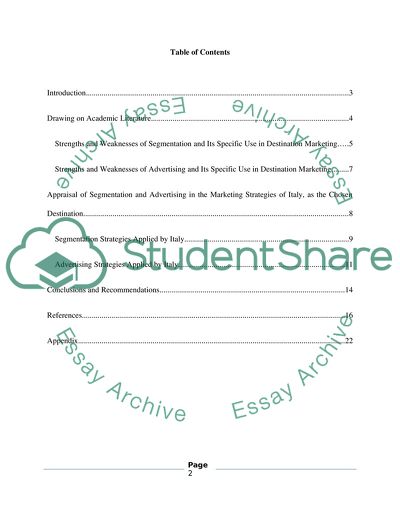Cite this document
(Appraisal of Segmentation and Advertising in the Marketing Strategies of Italy Case Study Example | Topics and Well Written Essays - 3250 words, n.d.)
Appraisal of Segmentation and Advertising in the Marketing Strategies of Italy Case Study Example | Topics and Well Written Essays - 3250 words. https://studentshare.org/marketing/1825376-in-this-essay-you-will-consider-the-following-focusing-on-segmentation-and-advertising-aspects-of-marketingdiscuss-and-evaluate-how-effectively-these-two-tools-have-been-used-by-a-tourism-destination-to-promote-itself-for-tourismin-this-case-the-chos
Appraisal of Segmentation and Advertising in the Marketing Strategies of Italy Case Study Example | Topics and Well Written Essays - 3250 words. https://studentshare.org/marketing/1825376-in-this-essay-you-will-consider-the-following-focusing-on-segmentation-and-advertising-aspects-of-marketingdiscuss-and-evaluate-how-effectively-these-two-tools-have-been-used-by-a-tourism-destination-to-promote-itself-for-tourismin-this-case-the-chos
(Appraisal of Segmentation and Advertising in the Marketing Strategies of Italy Case Study Example | Topics and Well Written Essays - 3250 Words)
Appraisal of Segmentation and Advertising in the Marketing Strategies of Italy Case Study Example | Topics and Well Written Essays - 3250 Words. https://studentshare.org/marketing/1825376-in-this-essay-you-will-consider-the-following-focusing-on-segmentation-and-advertising-aspects-of-marketingdiscuss-and-evaluate-how-effectively-these-two-tools-have-been-used-by-a-tourism-destination-to-promote-itself-for-tourismin-this-case-the-chos.
Appraisal of Segmentation and Advertising in the Marketing Strategies of Italy Case Study Example | Topics and Well Written Essays - 3250 Words. https://studentshare.org/marketing/1825376-in-this-essay-you-will-consider-the-following-focusing-on-segmentation-and-advertising-aspects-of-marketingdiscuss-and-evaluate-how-effectively-these-two-tools-have-been-used-by-a-tourism-destination-to-promote-itself-for-tourismin-this-case-the-chos.
“Appraisal of Segmentation and Advertising in the Marketing Strategies of Italy Case Study Example | Topics and Well Written Essays - 3250 Words”. https://studentshare.org/marketing/1825376-in-this-essay-you-will-consider-the-following-focusing-on-segmentation-and-advertising-aspects-of-marketingdiscuss-and-evaluate-how-effectively-these-two-tools-have-been-used-by-a-tourism-destination-to-promote-itself-for-tourismin-this-case-the-chos.


